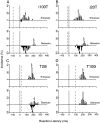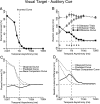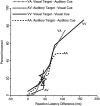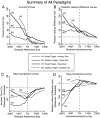The influence of auditory and visual distractors on human orienting gaze shifts
- PMID: 8987844
- PMCID: PMC6579210
- DOI: 10.1523/JNEUROSCI.16-24-08193.1996
The influence of auditory and visual distractors on human orienting gaze shifts
Abstract
We studied the influences of competing visual and auditory stimuli on horizontal gaze shifts in humans. Gaze shifts were made to visual or auditory targets in the presence of either an irrelevant visual or auditory cue. Within an experiment, the target and irrelevant cue were either aligned (enhancer condition) or misaligned (distractor condition) in space. The times of presentation of the target and irrelevant cue were varied so that the target could have been presented before the irrelevant cue, or the irrelevant cue before the target. We compared subject performance in the enhancer and distractor conditions, measuring reaction latencies and the frequency of incorrect gaze shifts. Performance differed the most when the irrelevant cue was presented before the target and differed the least when the target was presented before the irrelevant cue. Our results reveal that, in addition to the spatial and temporal register of the stimuli, the experimental context in which the stimuli are presented also influences multisensory integration: an irrelevant auditory cue influenced gaze shifts to visual targets differently than an irrelevant visual cue influenced gaze shifts to auditory targets. Furthermore, we observed patterns of influence unique to either visual or auditory irrelevant cues that occurred regardless of the modality of the target. We believe that subjects adopted a state of motor readiness that reflected the unique demands of target selection in each experiment and that this state modulated the influences of the irrelevant cue on the target.
Figures














Similar articles
-
Combined eye-head gaze shifts to visual and auditory targets in humans.Exp Brain Res. 1996 Sep;111(1):68-78. doi: 10.1007/BF00229557. Exp Brain Res. 1996. PMID: 8891638 Clinical Trial.
-
Interactions between voluntary and stimulus-driven spatial attention mechanisms across sensory modalities.J Cogn Neurosci. 2009 Dec;21(12):2384-97. doi: 10.1162/jocn.2008.21178. J Cogn Neurosci. 2009. PMID: 19199406
-
Human eye-head gaze shifts in a distractor task. II. Reduced threshold for initiation of early head movements.J Neurophysiol. 1999 Sep;82(3):1406-21. doi: 10.1152/jn.1999.82.3.1406. J Neurophysiol. 1999. PMID: 10482758
-
How attentional systems process conflicting cues. The superiority of social over symbolic orienting revisited.J Exp Psychol Hum Percept Perform. 2009 Dec;35(6):1738-54. doi: 10.1037/a0016472. J Exp Psychol Hum Percept Perform. 2009. PMID: 19968432
-
Gaze distractors influence saccadic curvature: evidence for the role of the oculomotor system in gaze-cued orienting.Vision Res. 2006 Oct;46(21):3674-80. doi: 10.1016/j.visres.2006.06.004. Epub 2006 Aug 9. Vision Res. 2006. PMID: 16901525
Cited by
-
Crossmodal interaction in saccadic reaction time: separating multisensory from warning effects in the time window of integration model.Exp Brain Res. 2008 Mar;186(1):1-22. doi: 10.1007/s00221-007-1197-4. Epub 2007 Nov 15. Exp Brain Res. 2008. PMID: 18004552
-
Using superior colliculus principles of multisensory integration to reverse hemianopia.Neuropsychologia. 2020 Apr;141:107413. doi: 10.1016/j.neuropsychologia.2020.107413. Epub 2020 Feb 27. Neuropsychologia. 2020. PMID: 32113921 Free PMC article.
-
Audio-Visual Integration in a Redundant Target Paradigm: A Comparison between Rhesus Macaque and Man.Front Syst Neurosci. 2017 Nov 29;11:89. doi: 10.3389/fnsys.2017.00089. eCollection 2017. Front Syst Neurosci. 2017. PMID: 29238295 Free PMC article.
-
Impact of response duration on multisensory integration.J Neurophysiol. 2012 Nov;108(9):2534-44. doi: 10.1152/jn.00286.2012. Epub 2012 Aug 15. J Neurophysiol. 2012. PMID: 22896723 Free PMC article.
-
Cortex mediates multisensory but not unisensory integration in superior colliculus.J Neurosci. 2007 Nov 21;27(47):12775-86. doi: 10.1523/JNEUROSCI.3524-07.2007. J Neurosci. 2007. PMID: 18032649 Free PMC article.
References
-
- Cavegn D. Bilateral interactions in saccade programming: a saccade-latency study. Exp Brain Res. 1996;109:312–332. - PubMed
-
- Corneil BD, Munoz DP. Effects of auditory stimuli on human gaze shifts to visual targets. Soc Neurosci Abstr. 1994;20:1402.
-
- Corneil BD, Munoz DP. Multisensory integration in the control of human gaze shifts. Neural Control Movement. 1996;1:27.
-
- Engelken EJ, Stevens KW. Saccadic eye movements in response to visual, auditory and bisensory stimuli. Avia Space Environ Med. 1989;60:762–768. - PubMed
Publication types
MeSH terms
LinkOut - more resources
Full Text Sources
